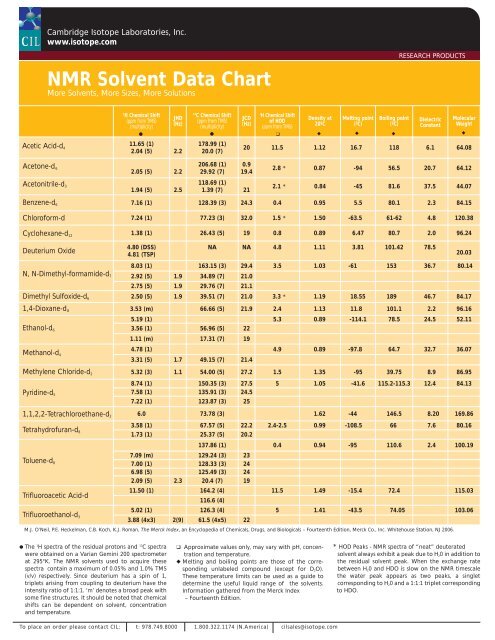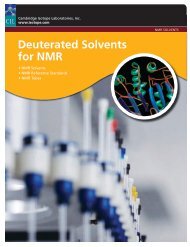NMR Solvent Data Chart - Cambridge Isotope Laboratories
NMR Solvent Data Chart - Cambridge Isotope Laboratories
NMR Solvent Data Chart - Cambridge Isotope Laboratories
Create successful ePaper yourself
Turn your PDF publications into a flip-book with our unique Google optimized e-Paper software.
31175_CIL <strong>NMR</strong> <strong>Chart</strong> R2-orange 5/27/10 1:21 PM Page 1<br />
Acetic Acid-d 4<br />
Acetone-d 6<br />
Acetonitrile-d 3<br />
<strong>Cambridge</strong> <strong>Isotope</strong> <strong>Laboratories</strong>, Inc.<br />
www.isotope.com<br />
<strong>NMR</strong> <strong>Solvent</strong> <strong>Data</strong> <strong>Chart</strong><br />
More <strong>Solvent</strong>s, More Sizes, More Solutions<br />
1H Chemical Shift<br />
(ppm from TMS)<br />
(multiplicity)<br />
M.J. O’Neil, P.E. Heckelman, C.B. Koch, K.J. Roman, The Merck Index, an Encyclopedia of Chemicals, Drugs, and Biologicals – Fourteenth Edition, Merck Co., Inc. Whitehouse Station, NJ 2006.<br />
● The 1 H spectra of the residual protons and 13 C spectra<br />
were obtained on a Varian Gemini 200 spectrometer<br />
at 295°K. The <strong>NMR</strong> solvents used to acquire these<br />
spectra contain a maximum of 0.05% and 1.0% TMS<br />
(v/v) respectively. Since deuterium has a spin of 1,<br />
triplets arising from coupling to deuterium have the<br />
intensity ratio of 1:1:1. ‘m’ denotes a broad peak with<br />
some fine structures. It should be noted that chemical<br />
shifts can be dependent on solvent, concentration<br />
and temperature.<br />
JHD<br />
(Hz)<br />
11.65 (1)<br />
2.04 (5) 2.2<br />
2.05 (5) 2.2<br />
1.94 (5) 2.5<br />
13C Chemical Shift<br />
(ppm from TMS)<br />
(multiplicity)<br />
178.99 (1)<br />
20.0 (7)<br />
206.68 (1)<br />
29.92 (7)<br />
JCD<br />
(Hz)<br />
1H Chemical Shift<br />
of HOD<br />
(ppm from TMS)<br />
Density at<br />
20ºC<br />
❑ Approximate values only, may vary with pH, concentration<br />
and temperature.<br />
◆ Melting and boiling points are those of the corresponding<br />
unlabeled compound (except for D 2O).<br />
These temperature limits can be used as a guide to<br />
determine the useful liquid range of the solvents.<br />
Information gathered from the Merck Index<br />
– Fourteenth Edition.<br />
Melting point<br />
(ºC)<br />
Boiling point<br />
(ºC)<br />
RESEARCH PRODUCTS<br />
Dielectric<br />
Constant<br />
Molecular<br />
Weight<br />
20 11.5 1.12 16.7 118 6.1 64.08<br />
0.9<br />
19.4<br />
118.69 (1)<br />
1.39 (7) 21<br />
2.8 * 0.87 -94 56.5 20.7 64.12<br />
2.1 * 0.84 -45 81.6 37.5 44.07<br />
Benzene-d 6 7.16 (1) 128.39 (3) 24.3 0.4 0.95 5.5 80.1 2.3 84.15<br />
Chloroform-d 7.24 (1) 77.23 (3) 32.0 1.5 * 1.50 -63.5 61-62 4.8 120.38<br />
Cyclohexane-d 12 1.38 (1) 26.43 (5) 19 0.8 0.89 6.47 80.7 2.0 96.24<br />
Deuterium Oxide<br />
N, N-Dimethyl-formamide-d 7<br />
4.80 (DSS)<br />
4.81 (TSP)<br />
NA NA 4.8 1.11 3.81 101.42 78.5<br />
8.03 (1) 163.15 (3) 29.4 3.5 1.03 -61 153 36.7 80.14<br />
2.92 (5) 1.9 34.89 (7) 21.0<br />
2.75 (5) 1.9 29.76 (7) 21.1<br />
Dimethyl Sulfoxide-d 6 2.50 (5) 1.9 39.51 (7) 21.0 3.3 * 1.19 18.55 189 46.7 84.17<br />
1,4-Dioxane-d 8 3.53 (m) 66.66 (5) 21.9 2.4 1.13 11.8 101.1 2.2 96.16<br />
Ethanol-d 6<br />
Methanol-d 4<br />
5.19 (1) 5.3 0.89 -114.1 78.5 24.5 52.11<br />
3.56 (1) 56.96 (5) 22<br />
1.11 (m) 17.31 (7) 19<br />
4.78 (1) 4.9 0.89 -97.8 64.7 32.7 36.07<br />
3.31 (5) 1.7 49.15 (7) 21.4<br />
Methylene Chloride-d 2 5.32 (3) 1.1 54.00 (5) 27.2 1.5 1.35 -95 39.75 8.9 86.95<br />
Pyridine-d 5<br />
8.74 (1) 150.35 (3) 27.5 5 1.05 -41.6 115.2-115.3 12.4 84.13<br />
7.58 (1) 135.91 (3) 24.5<br />
7.22 (1) 123.87 (3) 25<br />
1,1,2,2-Tetrachloroethane-d 2 6.0 73.78 (3) 1.62 -44 146.5 8.20 169.86<br />
Tetrahydrofuran-d 8<br />
Toluene-d 8<br />
Trifluoroacetic Acid-d<br />
Trifluoroethanol-d 3<br />
● ●<br />
❑ ◆<br />
◆ ◆<br />
3.58 (1) 67.57 (5) 22.2 2.4-2.5 0.99 -108.5 66 7.6 80.16<br />
1.73 (1) 25.37 (5) 20.2<br />
137.86 (1) 0.4 0.94 -95 110.6 2.4 100.19<br />
7.09 (m) 129.24 (3) 23<br />
7.00 (1) 128.33 (3) 24<br />
6.98 (5) 125.49 (3) 24<br />
2.09 (5) 2.3 20.4 (7) 19<br />
11.50 (1) 164.2 (4)<br />
116.6 (4)<br />
11.5 1.49 -15.4 72.4 115.03<br />
5.02 (1) 126.3 (4) 5 1.41 -43.5 74.05 103.06<br />
3.88 (4x3) 2(9) 61.5 (4x5) 22<br />
To place an order please contact CIL: t: 978.749.8000 1.800.322.1174 (N.America) cilsales@isotope.com<br />
20.03<br />
* HOD Peaks - <strong>NMR</strong> spectra of “neat” deuterated<br />
solvent always exhibit a peak due to H 20 in addition to<br />
the residual solvent peak. When the exchange rate<br />
between H 20 and HDO is slow on the <strong>NMR</strong> timescale<br />
the water peak appears as two peaks, a singlet<br />
corresponding to H 20 and a 1:1:1 triplet corresponding<br />
to HDO.<br />
◆
31175_CIL <strong>NMR</strong> <strong>Chart</strong> R2-orange 5/27/10 1:21 PM Page 2<br />
<strong>Cambridge</strong> <strong>Isotope</strong> <strong>Laboratories</strong>, Inc. l www.isotope.com<br />
<strong>NMR</strong> <strong>Solvent</strong> Storage and<br />
Handling Information<br />
Please note that some packaging sizes of some solvents may require special handling not given<br />
below. The bottle or ampoule packaging information should be reviewed for further instructions.<br />
Acetic Acid-d 4 / Acetone-d 6 / Benzene-d 6 / Cyclohexane-d 12 / Deuterium Oxide / N,N-Dimethylformamide-d 7 / Dimethyl Sulfoxide-d 6 /<br />
1,4-Dioxane-d 8 (p-Dioxane) / Ethanol-d 6 / Methanol-d 4 / Methylene Chloride-d 2 / Pyridine-d 5 / 1,1,2,2 Tetrachloroethane-d 2 /<br />
Toluene-d 8 / Trifluoroacetic Acid-d / 2,2,2-Trifluoroethanol-d 3<br />
Store at room temperature away from light and moisture. The above products are stable if stored under recommended conditions.<br />
Acetonitrile-d 3<br />
Store at room temperature away from light and moisture. This product is stable for one year after receipt of order if stored under<br />
above conditions (unopened). After one year, the solvent should be re-analyzed for chemical purity before use.<br />
Chloroform-d / Tetrahydrofuran-d 8<br />
Store refrigerated (-5 o to 5 o C) away from light and moisture. These products are stable for six months after receipt of order if stored<br />
under above conditions (unopened). After six months, the solvent should be re-analyzed for chemical purity before use.<br />
Deuterium Exchange of Labile Protons in Deuterated <strong>Solvent</strong>s containing Residual D 2O<br />
Some deuterated solvents are prepared by catalytic exchange of protonated solvent with deuterium oxide and carefully purified by<br />
distillation. Residual water (H 2O in equilibrium exchange with D 2O) is kept to a minimum of 20-200 ppm, the higher value corresponds<br />
to the amount in the more hygroscopic solvents. The labile deuterons (and protons) of water are available to exchange with labile<br />
protons in the chemist's sample and can result in inaccurate integration ratios. The example below shows that just 100 ppm of D 2O can<br />
cause problems when studying dilute solutions of analytes. A significant decrease in the integral of 1 labile proton may be observed<br />
in a sample containing 5 mg organic compound, MW~200, dissolved in 1g DMSO-d 6 containing 100 ppm D 2O. The problem becomes<br />
worse as the molecular weight of the analyte increases.<br />
Solution<br />
Water (as H 2O, HDO or D 2O) can be minimized by adding molecular sieves to the solvent, agitating the mixture and allowing it to<br />
stand for a few hours. The water content may be reduced to about 10-20 ppm in this manner. If exchange still causes a problem, it is<br />
recommended to use a less hygroscopic solvent, such as chloroform, methylene chloride or acetonitrile.<br />
X – residual solvent; – residual water<br />
2.01 1.00<br />
*<br />
Figure 1- 1 H <strong>NMR</strong> spectrum of 5.0 mg 2,6-di-tert-butyl-4-methylphenol<br />
(MW 220.36g/mole) in dry DMSO-d 6 . Note the proper integral ratios of<br />
18:3:1:2 (t-butyl: methyl: ring-H: -OH). Note the single H 2 O peak at 3.3 ppm.<br />
<strong>Cambridge</strong> <strong>Isotope</strong> <strong>Laboratories</strong>, Inc.<br />
50 Frontage Road, Andover MA 01810<br />
ph: 978.749.8000<br />
ph: 800.322.1174 (N. America)<br />
fax: 978.749.2768<br />
email: cilsales@isotope.com<br />
www.isotope.com<br />
*<br />
*<br />
X<br />
X<br />
3.02<br />
18.00<br />
2.01 0.47<br />
Figure 2- 1 H <strong>NMR</strong> spectrum of 5.3 mg of 2,6-di-tert-butyl-4-methylphenol<br />
in DMSO-d 6 with 100 ppm D 2 O added. Note the reduced ratio of the phenolic<br />
proton 18:3:2:0.47 (t-butyl: methyl: ring-H: -OH). Note that the HOH and HOD<br />
peaks are separated in the spectrum.<br />
*<br />
X<br />
2.99<br />
18.00







